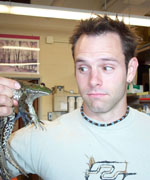|
 |
 |
        |
 |
|
Jon
Chatburn

|
MSc
Candidate, Zoology (UBC)
BSc Honours (Bishop's)
Contact
Info:
Department of Zoology
University of British Columbia
6270 University Blvd.
Vancouver, British Columbia
Canada, V6T 1Z4
Tel: (604) 822-5799
FAX: (604) 822-2416
jonchatburn@hotmail.com
chatburn@zoology.ubc.ca
|
|
Central
rhythm generation in amphibians
|
In
recent years there has been increasing
interest in the adaptive origins of
the respiratory control system in
vertebrate groups, specifically the
neural mechanisms generating the respiratory
rhythm and the influencing factors
that produce different breathing patterns.
Amphibians, in many
respects, represent the evolutionary
link between aquatic and terrestrial
vertebrates and therefore serve in
providing insight into the physiological,
morphological, and neurological adaptations
that were required for the transition
to life on land.
Most anuran amphibian
species exhibit breathing patterns
where the buccal cavity is ventilated
continuously, considered a remnant
of gill ventilation, and the lungs
intermittently, or episodically.
It is believed that these ventilatory
patterns represent two separate but
coordinated rhythms produced by separate
rhythm generators. It is proposed
that neurons responsible for respiratory
rhythm generation in frogs lies somewhere
within the medulla and that descending
inputs from the midbrain are responsible
for the clustering of lung breaths
into episodes.
My work will investigate
central rhythm generation in the bullfrog
(Rana catesbeiana) and to establish
the location of the CRG’s responsible
for lung and buccal ventilation. My
projects aim is to test the hypothesis
that in the caudal medulla of the
bullfrog brainstem, specifically the
area between the Vth and Xth cranial
nerves, there exists multiple segmental
rhythm generators. One set of
caudal bilateral oscillators that
are responsible for production of
the buccal ventilatory rhythm, and
another set of rostral bilateral oscillators
that are responsible for the production
of the lung ventilatory rhythm.
|
|
|